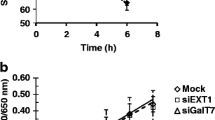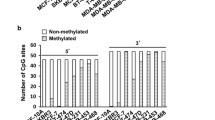Abstract
Sulfatase 2 (Sulf-2) has been previously shown to be upregulated in breast cancer. Sulf-2 removes sulfate moieties on heparan sulfate proteoglycans which in turn modulate heparin binding growth factor signaling. Here we report that matrix detachment resulted in decreased Sulf-2 expression in breast cancer cells and increased cleavage of poly ADP-ribose polymerase. Silencing of Sulf-2 promotes matrix detachment induced cell death in MCF10DCIS cells. In an attempt to identify Sulf-2 specific inhibitor, we found that proteasomal inhibitors such as MG132, Lactacystin and Bortezomib treatment abolished Sulf-2 expression in multiple breast cancer cell lines. Additionally, we show that Bortezomib treatment of MCF10DCIS cell xenografts in mouse mammary fat pads significantly reduced tumor size, caused massive apoptosis and more importantly reduced Sulf-2 levels in vivo. Finally, our immunohistochemistry analysis of Sulf-2 expression in cohort of patient derived breast tumors indicates that Sulf-2 is significantly upregulated in autologous metastatic lesions compared to primary tumors (p < 0.037, Pearson correlation, Chi-Square analysis). In all, our data suggest that Sulf-2 might play an important role in breast cancer progression from ductal carcinoma in situ into an invasive ductal carcinoma potentially by resisting cell death.





Similar content being viewed by others
Abbreviations
- Sulf-2:
-
Sulfatase 2
- MMP:
-
Matrix metalloproteases
- FGF2:
-
Fibroblast growth factor 2
- HSPGs:
-
Heparan sulfate proteoglycans
References
Bernfield M, Gotte M, Park PW et al (1999) Functions of cell surface heparan sulfate proteoglycans. Annu Rev Biochem 68:729–777
Chua CC, Rahimi N, Forsten-Williams K et al (2004) Heparan sulfate proteoglycans function as receptors for fibroblast growth factor-2 activation of extracellular signal-regulated kinases 1 and 2. Circ Res 94(3):316–323
Morimoto-Tomita M, Uchimura K, Werb Z et al (2002) Cloning and characterization of two extracellular heparin-degrading endosulfatases in mice and humans. J Biol Chem 277(51):49175–49185
Morimoto-Tomita M, Uchimura K, Bistrup A et al (2005) Sulf-2, a proangiogenic heparan sulfate endosulfatase, is upregulated in breast cancer. Neoplasia 7(11):1001–1010
Peterson SM, Iskenderian A, Cook L et al (2010) Human Sulfatase 2 inhibits in vivo tumor growth of MDA-MB-231 human breast cancer xenografts. BMC cancer 10:427
Khurana A, Liu P, Mellone P et al (2011) HSulf-1 modulates FGF2- and hypoxia-mediated migration and invasion of breast cancer cells. Cancer Res 71(6):2152–2161
Sabe H (2011) Cancer early dissemination: cancerous epithelial-mesenchymal transdifferentiation and transforming growth factor beta signalling. J Biochem 149(6):633–639
Tait LR, Pauley RJ, Santner SJ et al (2007) Dynamic stromal-epithelial interactions during progression of MCF10DCIS.com xenografts. Int J Cancer 120(10):2127–2134
Miller FR, Santner SJ, Tait L et al (2000) MCF10DCIS.com xenograft model of human comedo ductal carcinoma in situ. J Natl Cancer Inst 92(14):1185–1186
Nannuru KC, Futakuchi M, Varney ML et al (2010) Matrix metalloproteinase (MMP)-13 regulates mammary tumor-induced osteolysis by activating MMP9 and transforming growth factor-{beta} signaling at the tumor-bone interface. Cancer Res. doi:10.1158/0008-5472
Stetler-Stevenson WG (2001) The role of matrix metalloproteinases in tumor invasion, metastasis, and angiogenesis. Surg Oncol Clin N Am 10(2):383–392
Lai J, Chien J, Staub J et al (2003) Loss of HSulf-1 up-regulates heparin-binding growth factor signaling in cancer. J Biol Chem 278(25):23107–23117
Narita K, Staub J, Chien J et al (2006) HSulf-1 inhibits angiogenesis and tumorigenesis in vivo. Cancer Res 66(12):6025–6032
Khurana A, Nakayama K, Williams S et al (2006) Regulation of the ring finger E3 ligase Siah2 by p38 MAPK. J Biol Chem 281(46):35316–35326
Khurana A, Tun HW, Marlow L et al (2011) Hypoxia negatively regulates heparan sulfatase 2 expression in renal cancer cell lines. Mol carcinog 51(7):565–575
Khurana A, McKean H, Kim H et al (2012) Silencing of HSulf-2 expression in MCF10DCIS.com cells attenuate ductal carcinoma in situ progression to invasive ductal carcinoma in vivo. Breast Cancer Res 14(2):R43
Lai JP, Sandhu DS, Yu C et al (2008) Sulfatase 2 up-regulates glypican 3, promotes fibroblast growth factor signaling, and decreases survival in hepatocellular carcinoma. Hepatology 47(4):1211–1222
Shekhar MP, Tait L, Pauley RJ et al (2008) Comedo-ductal carcinoma in situ: a paradoxical role for programmed cell death. Cancer Biol Ther 7(11):1774–1782
Debnath J, Mills KR, Collins NL et al (2002) The role of apoptosis in creating and maintaining luminal space within normal and oncogene-expressing mammary acini. Cell 111(1):29–40
Reginato MJ, Mills KR, Paulus JK et al (2003) Integrins and EGFR coordinately regulate the pro-apoptotic protein bim to prevent anoikis. Nat Cell Biol 5(8):733–740
Haenssen KK, Caldwell SA, Shahriari KS et al (2010) ErbB2 requires integrin alpha5 for anoikis resistance via Src regulation of receptor activity in human mammary epithelial cells. J Cell Sci 123(Pt 8):1373–1382
Powers GL, Ellison-Zelski SJ, Casa AJ et al (2010) Proteasome inhibition represses ERalpha gene expression in ER+ cells: a new link between proteasome activity and estrogen signaling in breast cancer. Oncogene 29(10):1509–1518
Marx C, Yau C, Banwait S et al (2007) Proteasome-regulated ERBB2 and estrogen receptor pathways in breast cancer. Mol Pharmacol 71(6):1525–1534
Marx C, Held JM, Gibson BW et al (2010) ErbB2 trafficking and degradation associated with K48 and K63 polyubiquitination. Cancer Res 70(9):3709–3717
Lorch JH, Thomas TO, Schmoll HJ (2007) Bortezomib inhibits cell–cell adhesion and cell migration and enhances epidermal growth factor receptor inhibitor-induced cell death in squamous cell cancer. Cancer Res 67(2):727–734
Jones MD, Liu JC, Barthel TK et al (2010) A proteasome inhibitor, bortezomib, inhibits breast cancer growth and reduces osteolysis by downregulating metastatic genes. Clin Cancer Res 16(20):4978–4989
Codony-Servat J, Tapia MA, Bosch M et al (2006) Differential cellular and molecular effects of bortezomib, a proteasome inhibitor, in human breast cancer cells. Mol Cancer Ther 5(3):665–675
Acknowledgments
We thank members of Shridhar’s lab for insightful discussions. This work was supported by grants from the NCI, National Institutes of Health (CA106954-04), the Mayo Clinic (to VS) and the Korea Science and Engineering Foundation (KOSEF) grant funded by the Korea government (MEST 2011-0006220).
Conflict of interest
Authors do not have any conflict of interest.
Author information
Authors and Affiliations
Corresponding author
Electronic supplementary material
Below is the link to the electronic supplementary material.
Rights and permissions
About this article
Cite this article
Khurana, A., Jung-Beom, D., He, X. et al. Matrix detachment and proteasomal inhibitors diminish Sulf-2 expression in breast cancer cell lines and mouse xenografts. Clin Exp Metastasis 30, 407–415 (2013). https://doi.org/10.1007/s10585-012-9546-5
Received:
Accepted:
Published:
Issue Date:
DOI: https://doi.org/10.1007/s10585-012-9546-5




